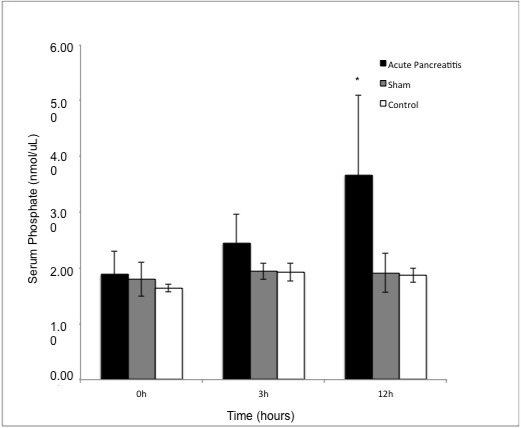|
|
Back to Annual Meeting Program Positive Correlation Between Serum Phosphate Levels and Acute Pancreatitis Severity in a Rat Model of Pancreatitis Induced by Sodium Taurocholate Guilherme D. Mazzini*1,2, Daniel T. Jost1, Rafael Machoseki1, Mateus a. Zeni1, Luiz V. Portela1, Maria I. Edelweiss2, Diogo O. Souza1, Alessandro B. Osvaldt2 1Biochemistry, Universidade Federal do Rio Grande do Sul, Porto Alegre, Brazil; 2Gastrointestinal Surgery, Hospital de Clinicas de Porto Alegre, Porto Alegre, Brazil
Introduction: Severe acute pancreatitis (AP) may lead to serious complications, with high mortality rates. Although several clinical and radiological scores and biochemical markers can determine if an episode of AP is severe, there is not available a precise predictor for the severity of the pancreatitis, which could allow an early intensive management of those patients. Our group has focused on the study of serum ecto-nucleotidase activity (NTPD-ases) and purine levels, and their possible role as predictor of severity in AP. Extracellular nucleotides play significant role in inflammation in peripheral circulation, and their serum levels are partially controlled by NTPD-ases. Consequently, those enzymes act as regulatory elements in inflammation, hydrolyzing nucleotides. However, results from our main experiments have shown an intriguing data, which could point to a possible marker of severity in AP, with a promising clinical use. Methods: The local ethics committee approved the study. AP was induced in 20 Wistar male rats, age 90-120 days, by retrograde infusion of sodium taurocholate in the pancreatic duct. Ten sham-operated animals were submitted to median laparotomy and closure. There were 5 absolute control animals. Blood was collected from the tail before surgery (time 0) and after 3h and from cardiac puncture at 12h, when pancreas were excised and fixed in formalin for histopathology. AP diagnosis was made based on amylase serum levels, determined by a colorimetric assay, and severity was graded by histopathology, using a validated scale (from 0 to 28 points). As a control for the colorimetric assay to determine NTPD-ase activity (measured by phosphate release), in each serum sample the basal phosphate levels were measured. These values produced interesting data, and will be presented here. Results: Four animals from AP group died before 12h. Additional 2 animals from AP group were excluded from the analysis due to invalid results. Serum amylase was diagnostic of AP in pancreatitis group, at 3h and 12h. Severity score in AP group was 19.0 ± 4.9 (mean ± SD). Basal phosphate levels at 12h were significantly higher than 0h and 3h in AP group, and significantly higher than 0h, 3h and 12h, in sham and control groups, which did not present significant alterations in phosphate levels along the experiment (Figure 1). Additionally, in AP group, phosphate levels at 12h showed a positive correlation with the severity of the pancreatitis, r=0.74 (Pearson’s coefficient, p=0.02) (Figure 2). Discussion: Our group brings preliminary experimental results with a novel approach to the assessment of severe AP. Although the strong correlation between pancreatitis severity and serum phosphate levels was observed late in the course of the experimental pancreatitis, it could be usefully evaluated in experimental and clinical studies. Back to Annual Meeting Program
|
||||||||
© 2026 Society for Surgery of the Alimentary Tract. All Rights Reserved. Read the Privacy Policy.



